Habitat and Distribution
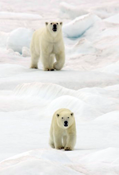
Polar bear populations can be found in northern Canada, Greenland, Norway and Russia, and there have been reports that polar bear tracks have been found as far north as the North Pole. The five million square-mile range of the polar bear circles the Arctic and contains stretches of open water where its primary prey - seals - are easily caught.
Polar bears live on the annual Arctic sea ice that provides a platform from which they can hunt. But when the edge of the ice retreats to the north during summer, bears must follow the ice floes or become stranded on land where they must stay until the sea ice forms again in the fall.
Status
With about 22,000 polar bears living in the wild, the species is not currently endangered, but its future is far from certain. In 1973, Canada, the United States, Denmark, Norway and the former U.S.S.R. signed the International Agreement on the Conservation of Polar Bears and their Habitat. This agreement restricts the hunting of polar bears and directs each nation to protect their habitats, but it does not protect the bears against the biggest man-made threat to their survival: global warming.
If current warming trends continue unabated, scientists believe that polar bears may disappear within 100 years.
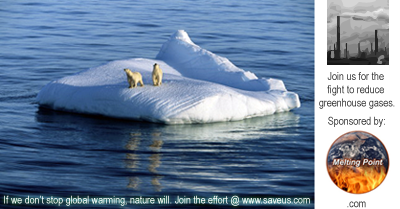
The Arctic and Alaska
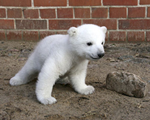 The Arctic is thawing very rapidly, documented by new reports from scientists and arctic natives. The Arctic Climate Impact Assessment was released in late 2004, and shows changes from the ice at the North Pole to animals and human settlements. More recent reports from Greenland show outlet glaciers moving meters per hour and rapidly thinning. The Arctic Ocean ice cap is shrinking in summer to the smallest it has ever been in modern measurements, and even winter cold has not been refreezing it as extensively as before. That sea ice is habitat for the polar bear. Declines in bear nutrition, birth weight and survival have moved the U.S. government (urged by three environmental groups) to propose the bear be named a species threatened with extinction.
The Arctic is thawing very rapidly, documented by new reports from scientists and arctic natives. The Arctic Climate Impact Assessment was released in late 2004, and shows changes from the ice at the North Pole to animals and human settlements. More recent reports from Greenland show outlet glaciers moving meters per hour and rapidly thinning. The Arctic Ocean ice cap is shrinking in summer to the smallest it has ever been in modern measurements, and even winter cold has not been refreezing it as extensively as before. That sea ice is habitat for the polar bear. Declines in bear nutrition, birth weight and survival have moved the U.S. government (urged by three environmental groups) to propose the bear be named a species threatened with extinction.

News
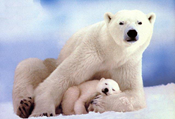
Polar bear habitat is at risk from the effects of climate change. Around the world, climate change is threatening not only individual species such as polar bears, tigers, salmon, penguins and corals, but it is also posing potentially catastrophic and long-term changes to the environment and people's lives around the world.
In addition to rising temperatures, climate change is resulting in sea level rise, increased hurricane intensity, glacier decline, increased drought, spread of disease, shifts in the timing of seasons, increased flooding, changes in freshwater supply, and an increase in extreme weather events.
Polar Bears
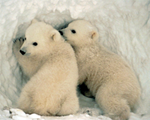
The polar bear's coat, covering it completely except for the nose and foot pads, is superbly adapted to Arctic environments. Along with a thick layer of body fat, the water-repellent coat insulates the bear from cold air and water. It also serves as camouflage; in fact, polar bears can sometimes pass as snow drifts. The fur is 95 percent efficient in converting ultra-violet sun rays into usable heat. Its transparent hairs have a hollow inner core which scatters ultra-violet light by some unknown mechanism, converting it into heat when it reaches the bear's black skin. Surprisingly, the fur has no white pigment; it is the reflection of the sun that causes the fur to appear white.
Arctic Coasts
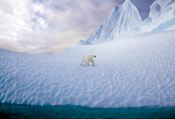 The polar bear is found on the arctic coasts and islands of the five countries around the North Pole, the United States (Alaska), Canada, Denmark (Greenland), Norway and Russia. It is the only species that still lives throughout its original range, with an estimated 20,000 still in the wild.
The polar bear is found on the arctic coasts and islands of the five countries around the North Pole, the United States (Alaska), Canada, Denmark (Greenland), Norway and Russia. It is the only species that still lives throughout its original range, with an estimated 20,000 still in the wild.
However, even in the seemingly pristine Arctic environment, polar bears are threatened by the spread of hormone-disrupting chemicals and global warming. This affects the polar ice edge ecosystem, the habitat of walrus, seals and penguins, as well as bears.
Global warming could already be having a negative impact on polar bears. In Canada's Hudson Bay, numbers have been declining according to a study by Canadian Wildlife Services. Ice on the bay is melting an average of three weeks earlier than in the mid-1970s. This forces polar bears to retreat further inland before they have been able to replenish their reserves of fat by feeding on seal pups, which live on the ice.
The polar bears in the Hudson Bay are unique in the Arctic because they fast for six to eight months of hibernation and rely on winter hunting for survival. Longer ice-free periods during the artic summer leave polar bears stranded onshore for longer periods. The delay in freeze-up causes polar bears to lose critical fat reserves affecting reproduction and the ability of pregnant females to produce enough milk for their cubs. Scientists can already document a 15 percent drop in birth rates.
ALL TEXT TAKEN FROM: Wikipedia.org, Epa.gov, Fightglobalwarming.com, Globalwarming.org

